Managing Food Production
VerifiedAdded on 2023/01/11
|11
|3166
|93
AI Summary
This report discusses the management of food production in the context of Blue Star Restaurant, specializing in Chinese cuisine. It covers the range of food preparation and production systems, their influence on design, and a comparison of different systems. The report also explores the advantages and disadvantages of various methods of food preparation and production, as well as different types of kitchen layouts. It provides insights into meeting customer requirements and justifies the selection of specific kitchen layouts. Overall, it offers expert guidance on managing food production effectively and efficiently.
Contribute Materials
Your contribution can guide someone’s learning journey. Share your
documents today.
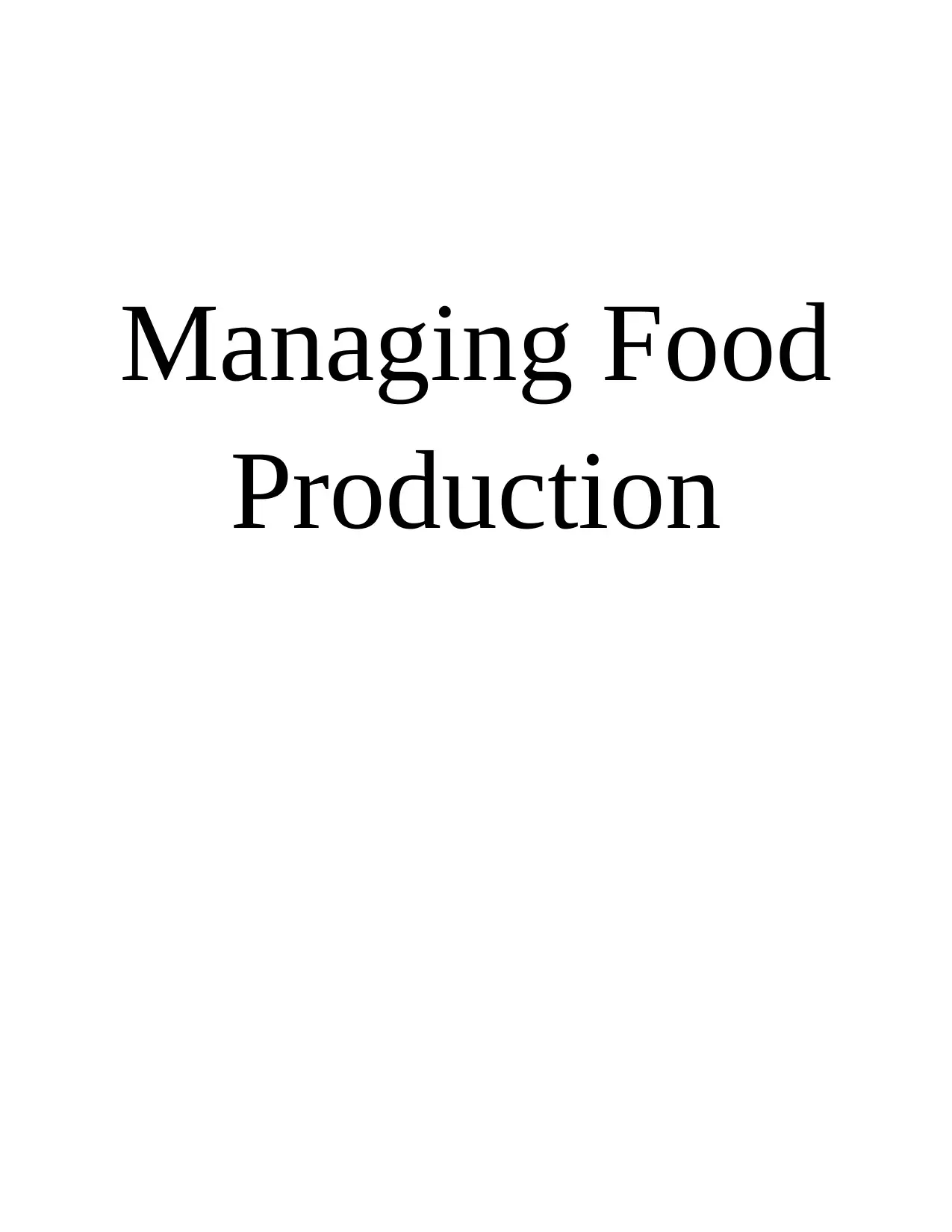
Managing Food
Production
Production
Secure Best Marks with AI Grader
Need help grading? Try our AI Grader for instant feedback on your assignments.
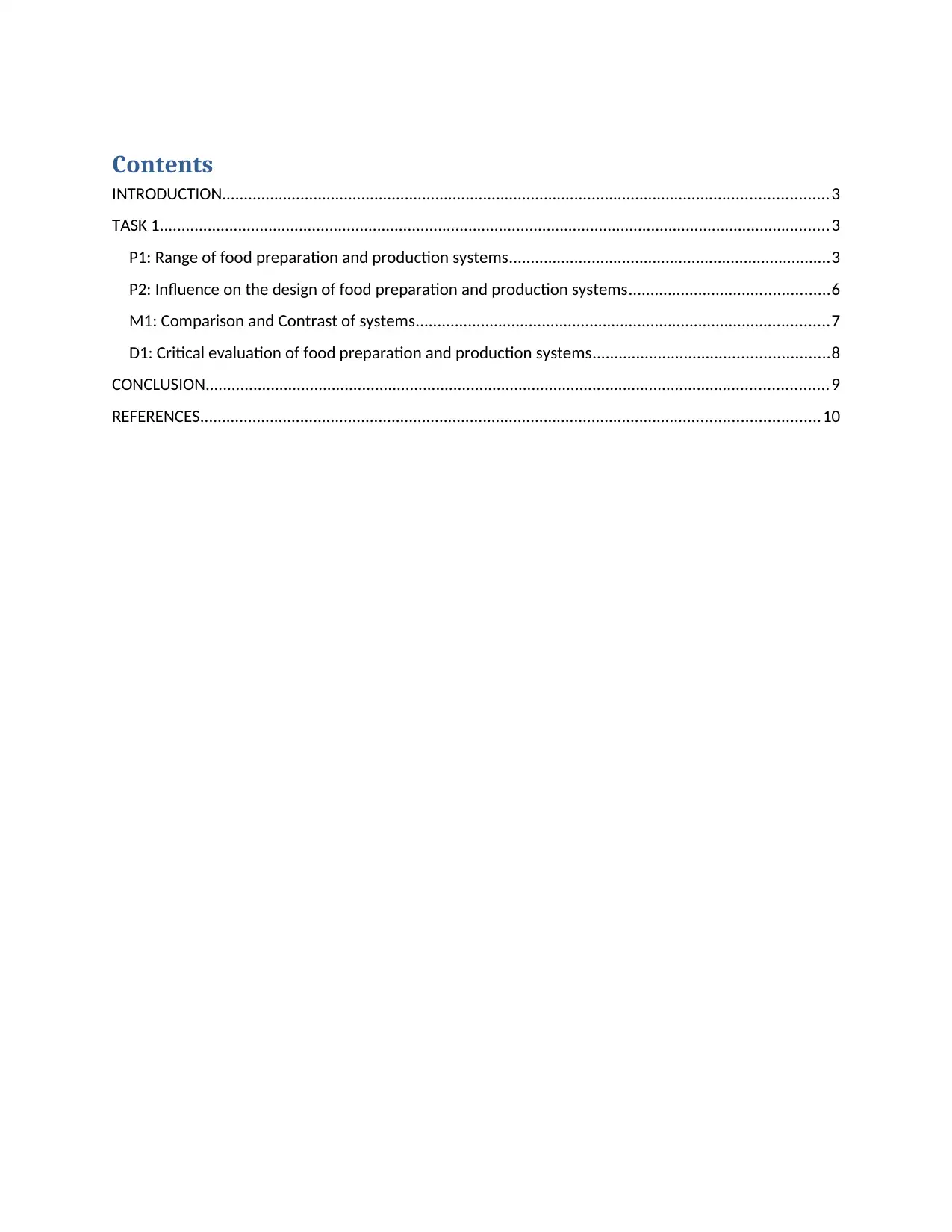
Contents
INTRODUCTION...........................................................................................................................................3
TASK 1..........................................................................................................................................................3
P1: Range of food preparation and production systems..........................................................................3
P2: Influence on the design of food preparation and production systems..............................................6
M1: Comparison and Contrast of systems...............................................................................................7
D1: Critical evaluation of food preparation and production systems......................................................8
CONCLUSION...............................................................................................................................................9
REFERENCES..............................................................................................................................................10
INTRODUCTION...........................................................................................................................................3
TASK 1..........................................................................................................................................................3
P1: Range of food preparation and production systems..........................................................................3
P2: Influence on the design of food preparation and production systems..............................................6
M1: Comparison and Contrast of systems...............................................................................................7
D1: Critical evaluation of food preparation and production systems......................................................8
CONCLUSION...............................................................................................................................................9
REFERENCES..............................................................................................................................................10
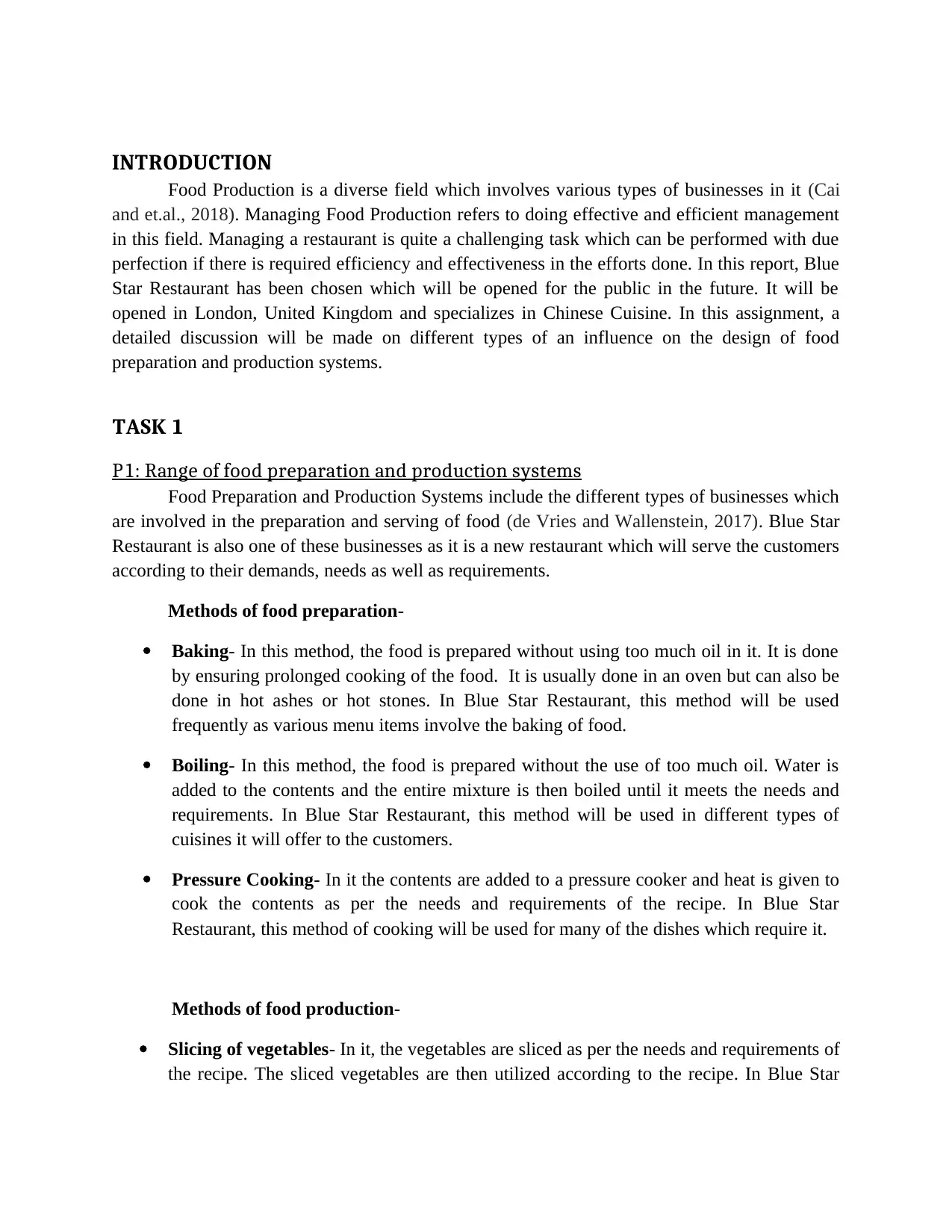
INTRODUCTION
Food Production is a diverse field which involves various types of businesses in it (Cai
and et.al., 2018). Managing Food Production refers to doing effective and efficient management
in this field. Managing a restaurant is quite a challenging task which can be performed with due
perfection if there is required efficiency and effectiveness in the efforts done. In this report, Blue
Star Restaurant has been chosen which will be opened for the public in the future. It will be
opened in London, United Kingdom and specializes in Chinese Cuisine. In this assignment, a
detailed discussion will be made on different types of an influence on the design of food
preparation and production systems.
TASK 1
P1: Range of food preparation and production systems
Food Preparation and Production Systems include the different types of businesses which
are involved in the preparation and serving of food (de Vries and Wallenstein, 2017). Blue Star
Restaurant is also one of these businesses as it is a new restaurant which will serve the customers
according to their demands, needs as well as requirements.
Methods of food preparation-
Baking- In this method, the food is prepared without using too much oil in it. It is done
by ensuring prolonged cooking of the food. It is usually done in an oven but can also be
done in hot ashes or hot stones. In Blue Star Restaurant, this method will be used
frequently as various menu items involve the baking of food.
Boiling- In this method, the food is prepared without the use of too much oil. Water is
added to the contents and the entire mixture is then boiled until it meets the needs and
requirements. In Blue Star Restaurant, this method will be used in different types of
cuisines it will offer to the customers.
Pressure Cooking- In it the contents are added to a pressure cooker and heat is given to
cook the contents as per the needs and requirements of the recipe. In Blue Star
Restaurant, this method of cooking will be used for many of the dishes which require it.
Methods of food production-
Slicing of vegetables- In it, the vegetables are sliced as per the needs and requirements of
the recipe. The sliced vegetables are then utilized according to the recipe. In Blue Star
Food Production is a diverse field which involves various types of businesses in it (Cai
and et.al., 2018). Managing Food Production refers to doing effective and efficient management
in this field. Managing a restaurant is quite a challenging task which can be performed with due
perfection if there is required efficiency and effectiveness in the efforts done. In this report, Blue
Star Restaurant has been chosen which will be opened for the public in the future. It will be
opened in London, United Kingdom and specializes in Chinese Cuisine. In this assignment, a
detailed discussion will be made on different types of an influence on the design of food
preparation and production systems.
TASK 1
P1: Range of food preparation and production systems
Food Preparation and Production Systems include the different types of businesses which
are involved in the preparation and serving of food (de Vries and Wallenstein, 2017). Blue Star
Restaurant is also one of these businesses as it is a new restaurant which will serve the customers
according to their demands, needs as well as requirements.
Methods of food preparation-
Baking- In this method, the food is prepared without using too much oil in it. It is done
by ensuring prolonged cooking of the food. It is usually done in an oven but can also be
done in hot ashes or hot stones. In Blue Star Restaurant, this method will be used
frequently as various menu items involve the baking of food.
Boiling- In this method, the food is prepared without the use of too much oil. Water is
added to the contents and the entire mixture is then boiled until it meets the needs and
requirements. In Blue Star Restaurant, this method will be used in different types of
cuisines it will offer to the customers.
Pressure Cooking- In it the contents are added to a pressure cooker and heat is given to
cook the contents as per the needs and requirements of the recipe. In Blue Star
Restaurant, this method of cooking will be used for many of the dishes which require it.
Methods of food production-
Slicing of vegetables- In it, the vegetables are sliced as per the needs and requirements of
the recipe. The sliced vegetables are then utilized according to the recipe. In Blue Star
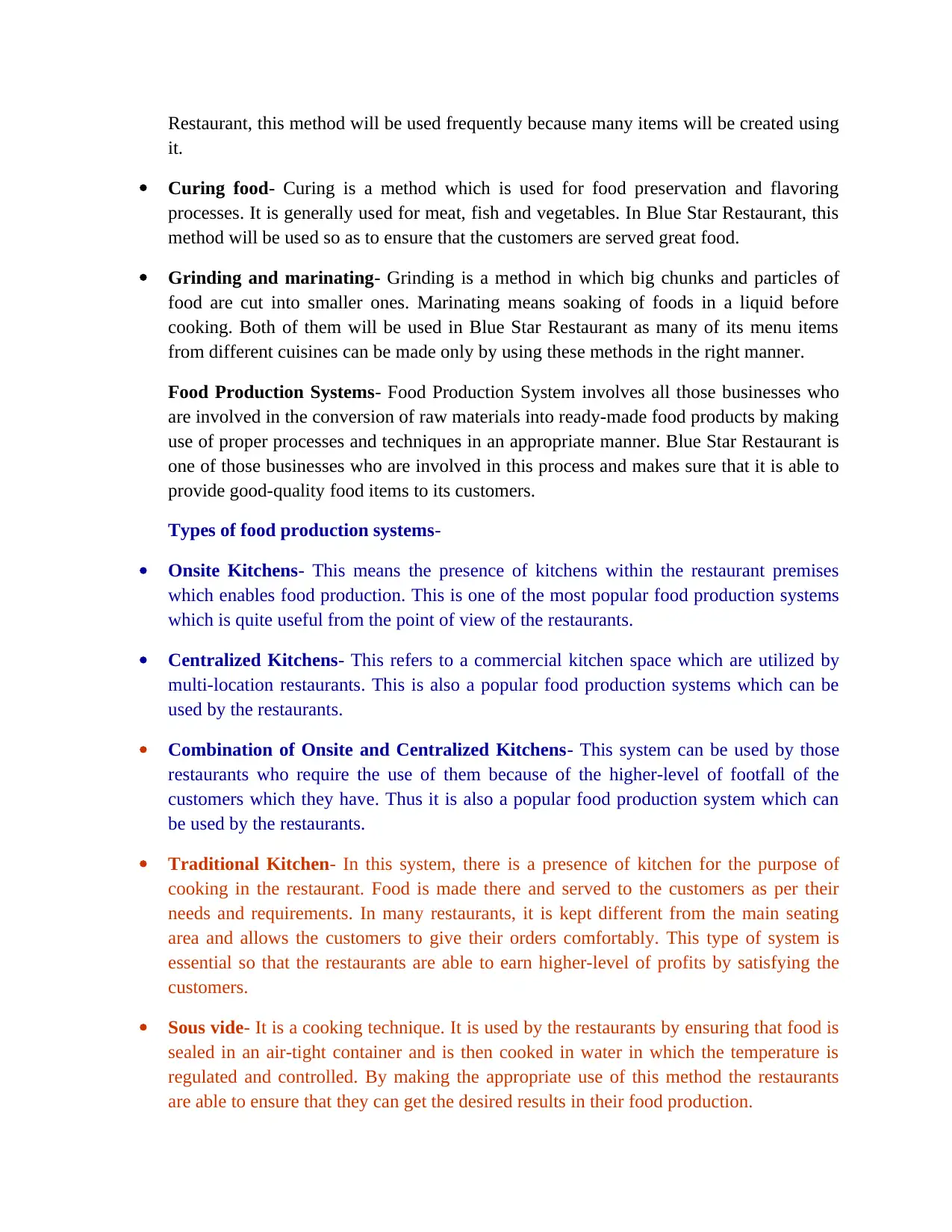
Restaurant, this method will be used frequently because many items will be created using
it.
Curing food- Curing is a method which is used for food preservation and flavoring
processes. It is generally used for meat, fish and vegetables. In Blue Star Restaurant, this
method will be used so as to ensure that the customers are served great food.
Grinding and marinating- Grinding is a method in which big chunks and particles of
food are cut into smaller ones. Marinating means soaking of foods in a liquid before
cooking. Both of them will be used in Blue Star Restaurant as many of its menu items
from different cuisines can be made only by using these methods in the right manner.
Food Production Systems- Food Production System involves all those businesses who
are involved in the conversion of raw materials into ready-made food products by making
use of proper processes and techniques in an appropriate manner. Blue Star Restaurant is
one of those businesses who are involved in this process and makes sure that it is able to
provide good-quality food items to its customers.
Types of food production systems-
Onsite Kitchens- This means the presence of kitchens within the restaurant premises
which enables food production. This is one of the most popular food production systems
which is quite useful from the point of view of the restaurants.
Centralized Kitchens- This refers to a commercial kitchen space which are utilized by
multi-location restaurants. This is also a popular food production systems which can be
used by the restaurants.
Combination of Onsite and Centralized Kitchens- This system can be used by those
restaurants who require the use of them because of the higher-level of footfall of the
customers which they have. Thus it is also a popular food production system which can
be used by the restaurants.
Traditional Kitchen- In this system, there is a presence of kitchen for the purpose of
cooking in the restaurant. Food is made there and served to the customers as per their
needs and requirements. In many restaurants, it is kept different from the main seating
area and allows the customers to give their orders comfortably. This type of system is
essential so that the restaurants are able to earn higher-level of profits by satisfying the
customers.
Sous vide- It is a cooking technique. It is used by the restaurants by ensuring that food is
sealed in an air-tight container and is then cooked in water in which the temperature is
regulated and controlled. By making the appropriate use of this method the restaurants
are able to ensure that they can get the desired results in their food production.
it.
Curing food- Curing is a method which is used for food preservation and flavoring
processes. It is generally used for meat, fish and vegetables. In Blue Star Restaurant, this
method will be used so as to ensure that the customers are served great food.
Grinding and marinating- Grinding is a method in which big chunks and particles of
food are cut into smaller ones. Marinating means soaking of foods in a liquid before
cooking. Both of them will be used in Blue Star Restaurant as many of its menu items
from different cuisines can be made only by using these methods in the right manner.
Food Production Systems- Food Production System involves all those businesses who
are involved in the conversion of raw materials into ready-made food products by making
use of proper processes and techniques in an appropriate manner. Blue Star Restaurant is
one of those businesses who are involved in this process and makes sure that it is able to
provide good-quality food items to its customers.
Types of food production systems-
Onsite Kitchens- This means the presence of kitchens within the restaurant premises
which enables food production. This is one of the most popular food production systems
which is quite useful from the point of view of the restaurants.
Centralized Kitchens- This refers to a commercial kitchen space which are utilized by
multi-location restaurants. This is also a popular food production systems which can be
used by the restaurants.
Combination of Onsite and Centralized Kitchens- This system can be used by those
restaurants who require the use of them because of the higher-level of footfall of the
customers which they have. Thus it is also a popular food production system which can
be used by the restaurants.
Traditional Kitchen- In this system, there is a presence of kitchen for the purpose of
cooking in the restaurant. Food is made there and served to the customers as per their
needs and requirements. In many restaurants, it is kept different from the main seating
area and allows the customers to give their orders comfortably. This type of system is
essential so that the restaurants are able to earn higher-level of profits by satisfying the
customers.
Sous vide- It is a cooking technique. It is used by the restaurants by ensuring that food is
sealed in an air-tight container and is then cooked in water in which the temperature is
regulated and controlled. By making the appropriate use of this method the restaurants
are able to ensure that they can get the desired results in their food production.
Secure Best Marks with AI Grader
Need help grading? Try our AI Grader for instant feedback on your assignments.
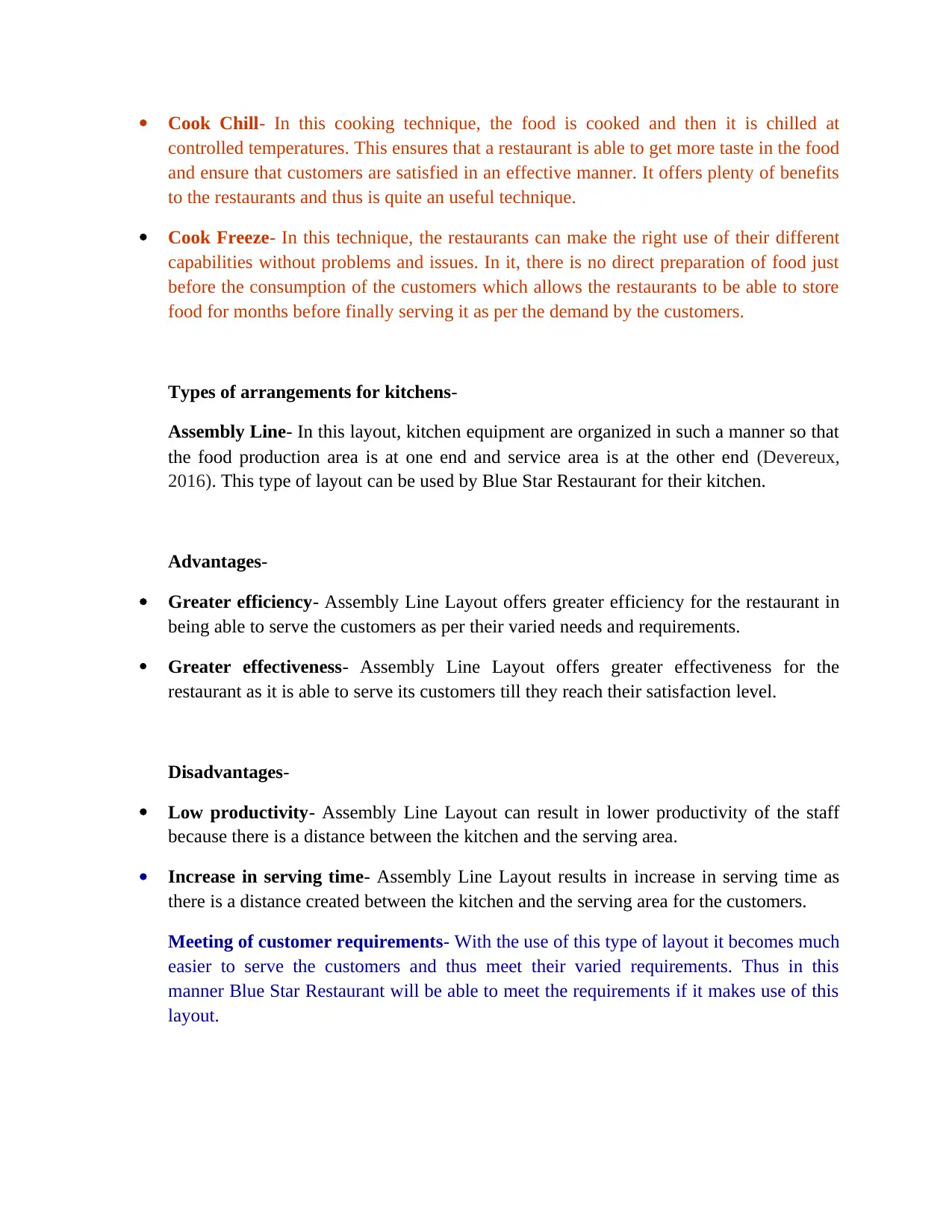
Cook Chill- In this cooking technique, the food is cooked and then it is chilled at
controlled temperatures. This ensures that a restaurant is able to get more taste in the food
and ensure that customers are satisfied in an effective manner. It offers plenty of benefits
to the restaurants and thus is quite an useful technique.
Cook Freeze- In this technique, the restaurants can make the right use of their different
capabilities without problems and issues. In it, there is no direct preparation of food just
before the consumption of the customers which allows the restaurants to be able to store
food for months before finally serving it as per the demand by the customers.
Types of arrangements for kitchens-
Assembly Line- In this layout, kitchen equipment are organized in such a manner so that
the food production area is at one end and service area is at the other end (Devereux,
2016). This type of layout can be used by Blue Star Restaurant for their kitchen.
Advantages-
Greater efficiency- Assembly Line Layout offers greater efficiency for the restaurant in
being able to serve the customers as per their varied needs and requirements.
Greater effectiveness- Assembly Line Layout offers greater effectiveness for the
restaurant as it is able to serve its customers till they reach their satisfaction level.
Disadvantages-
Low productivity- Assembly Line Layout can result in lower productivity of the staff
because there is a distance between the kitchen and the serving area.
Increase in serving time- Assembly Line Layout results in increase in serving time as
there is a distance created between the kitchen and the serving area for the customers.
Meeting of customer requirements- With the use of this type of layout it becomes much
easier to serve the customers and thus meet their varied requirements. Thus in this
manner Blue Star Restaurant will be able to meet the requirements if it makes use of this
layout.
controlled temperatures. This ensures that a restaurant is able to get more taste in the food
and ensure that customers are satisfied in an effective manner. It offers plenty of benefits
to the restaurants and thus is quite an useful technique.
Cook Freeze- In this technique, the restaurants can make the right use of their different
capabilities without problems and issues. In it, there is no direct preparation of food just
before the consumption of the customers which allows the restaurants to be able to store
food for months before finally serving it as per the demand by the customers.
Types of arrangements for kitchens-
Assembly Line- In this layout, kitchen equipment are organized in such a manner so that
the food production area is at one end and service area is at the other end (Devereux,
2016). This type of layout can be used by Blue Star Restaurant for their kitchen.
Advantages-
Greater efficiency- Assembly Line Layout offers greater efficiency for the restaurant in
being able to serve the customers as per their varied needs and requirements.
Greater effectiveness- Assembly Line Layout offers greater effectiveness for the
restaurant as it is able to serve its customers till they reach their satisfaction level.
Disadvantages-
Low productivity- Assembly Line Layout can result in lower productivity of the staff
because there is a distance between the kitchen and the serving area.
Increase in serving time- Assembly Line Layout results in increase in serving time as
there is a distance created between the kitchen and the serving area for the customers.
Meeting of customer requirements- With the use of this type of layout it becomes much
easier to serve the customers and thus meet their varied requirements. Thus in this
manner Blue Star Restaurant will be able to meet the requirements if it makes use of this
layout.
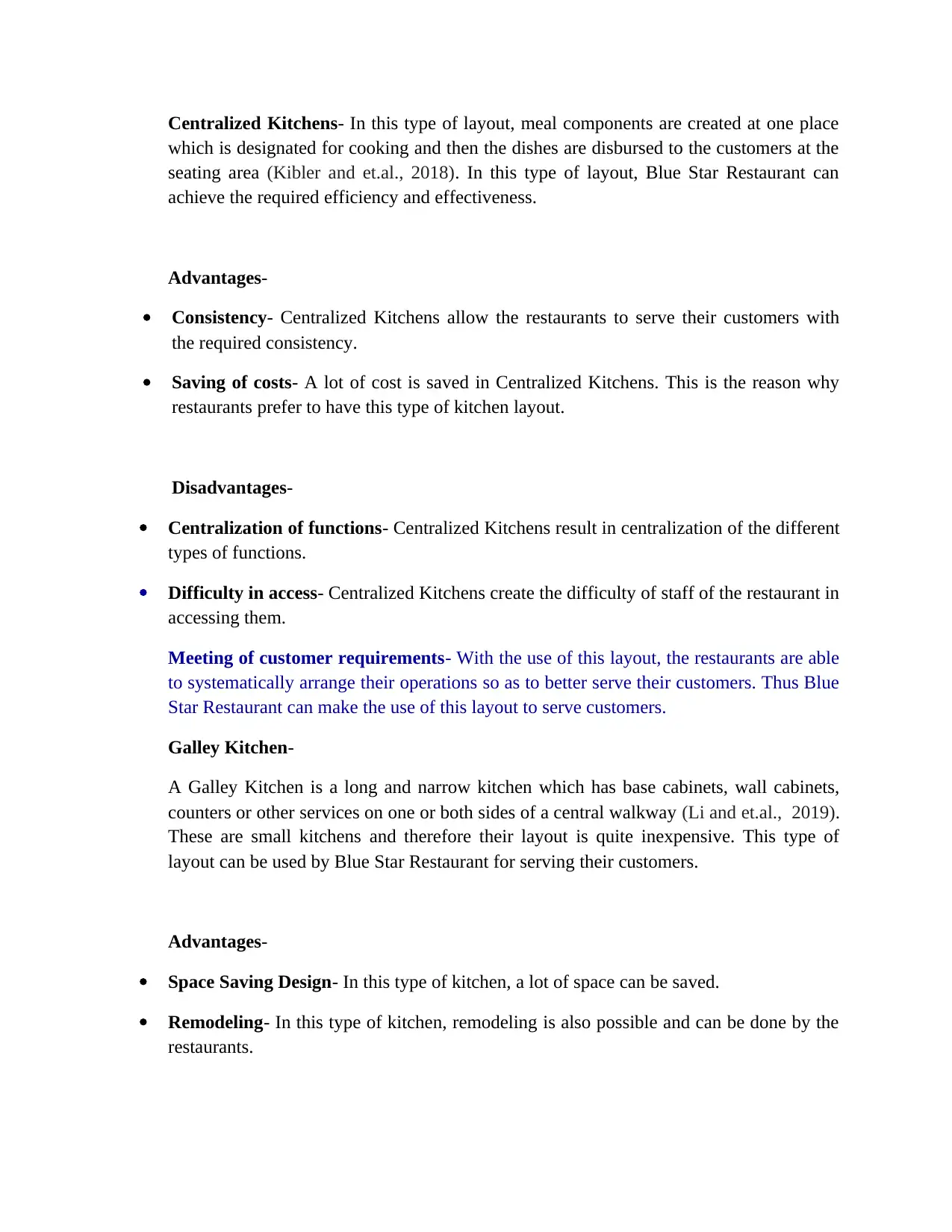
Centralized Kitchens- In this type of layout, meal components are created at one place
which is designated for cooking and then the dishes are disbursed to the customers at the
seating area (Kibler and et.al., 2018). In this type of layout, Blue Star Restaurant can
achieve the required efficiency and effectiveness.
Advantages-
Consistency- Centralized Kitchens allow the restaurants to serve their customers with
the required consistency.
Saving of costs- A lot of cost is saved in Centralized Kitchens. This is the reason why
restaurants prefer to have this type of kitchen layout.
Disadvantages-
Centralization of functions- Centralized Kitchens result in centralization of the different
types of functions.
Difficulty in access- Centralized Kitchens create the difficulty of staff of the restaurant in
accessing them.
Meeting of customer requirements- With the use of this layout, the restaurants are able
to systematically arrange their operations so as to better serve their customers. Thus Blue
Star Restaurant can make the use of this layout to serve customers.
Galley Kitchen-
A Galley Kitchen is a long and narrow kitchen which has base cabinets, wall cabinets,
counters or other services on one or both sides of a central walkway (Li and et.al., 2019).
These are small kitchens and therefore their layout is quite inexpensive. This type of
layout can be used by Blue Star Restaurant for serving their customers.
Advantages-
Space Saving Design- In this type of kitchen, a lot of space can be saved.
Remodeling- In this type of kitchen, remodeling is also possible and can be done by the
restaurants.
which is designated for cooking and then the dishes are disbursed to the customers at the
seating area (Kibler and et.al., 2018). In this type of layout, Blue Star Restaurant can
achieve the required efficiency and effectiveness.
Advantages-
Consistency- Centralized Kitchens allow the restaurants to serve their customers with
the required consistency.
Saving of costs- A lot of cost is saved in Centralized Kitchens. This is the reason why
restaurants prefer to have this type of kitchen layout.
Disadvantages-
Centralization of functions- Centralized Kitchens result in centralization of the different
types of functions.
Difficulty in access- Centralized Kitchens create the difficulty of staff of the restaurant in
accessing them.
Meeting of customer requirements- With the use of this layout, the restaurants are able
to systematically arrange their operations so as to better serve their customers. Thus Blue
Star Restaurant can make the use of this layout to serve customers.
Galley Kitchen-
A Galley Kitchen is a long and narrow kitchen which has base cabinets, wall cabinets,
counters or other services on one or both sides of a central walkway (Li and et.al., 2019).
These are small kitchens and therefore their layout is quite inexpensive. This type of
layout can be used by Blue Star Restaurant for serving their customers.
Advantages-
Space Saving Design- In this type of kitchen, a lot of space can be saved.
Remodeling- In this type of kitchen, remodeling is also possible and can be done by the
restaurants.
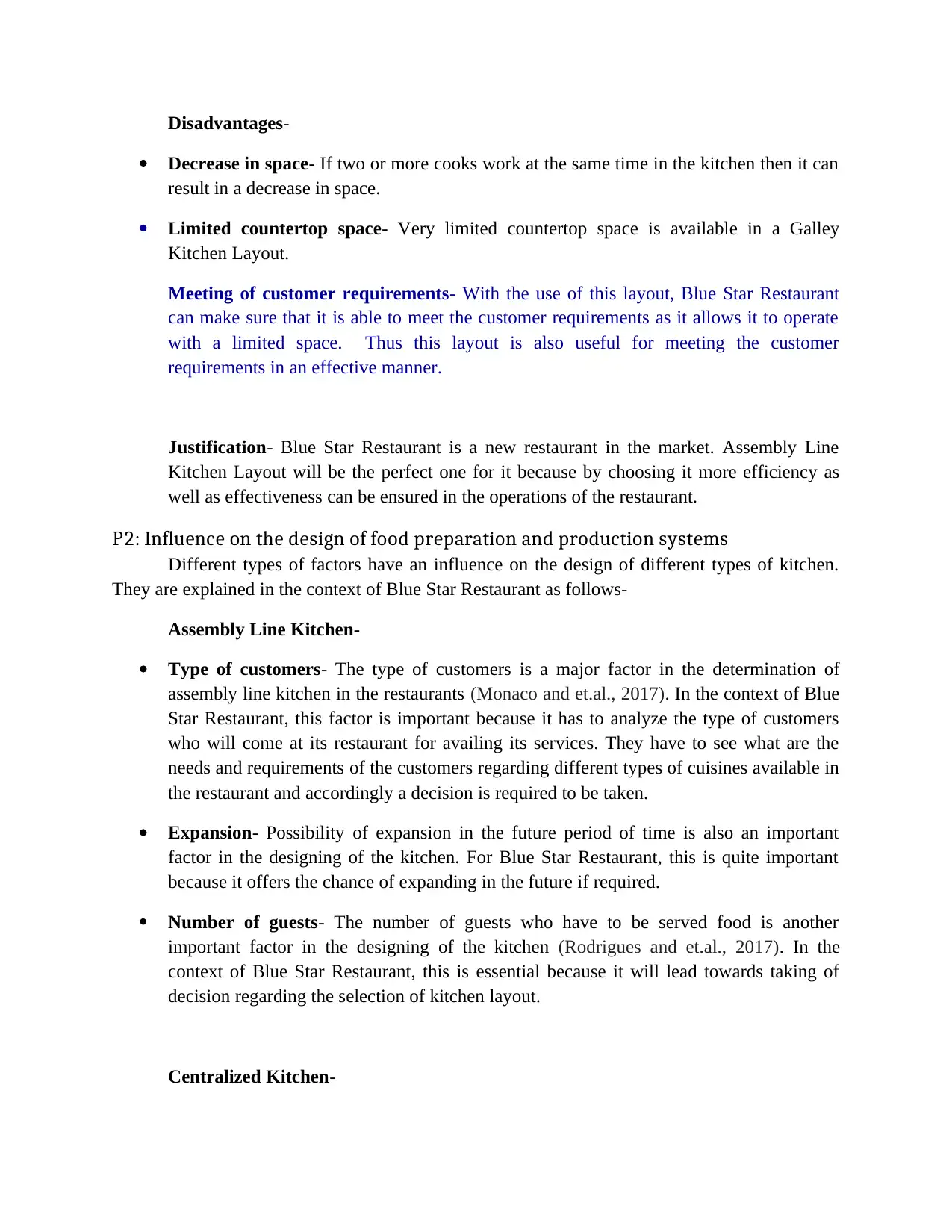
Disadvantages-
Decrease in space- If two or more cooks work at the same time in the kitchen then it can
result in a decrease in space.
Limited countertop space- Very limited countertop space is available in a Galley
Kitchen Layout.
Meeting of customer requirements- With the use of this layout, Blue Star Restaurant
can make sure that it is able to meet the customer requirements as it allows it to operate
with a limited space. Thus this layout is also useful for meeting the customer
requirements in an effective manner.
Justification- Blue Star Restaurant is a new restaurant in the market. Assembly Line
Kitchen Layout will be the perfect one for it because by choosing it more efficiency as
well as effectiveness can be ensured in the operations of the restaurant.
P2: Influence on the design of food preparation and production systems
Different types of factors have an influence on the design of different types of kitchen.
They are explained in the context of Blue Star Restaurant as follows-
Assembly Line Kitchen-
Type of customers- The type of customers is a major factor in the determination of
assembly line kitchen in the restaurants (Monaco and et.al., 2017). In the context of Blue
Star Restaurant, this factor is important because it has to analyze the type of customers
who will come at its restaurant for availing its services. They have to see what are the
needs and requirements of the customers regarding different types of cuisines available in
the restaurant and accordingly a decision is required to be taken.
Expansion- Possibility of expansion in the future period of time is also an important
factor in the designing of the kitchen. For Blue Star Restaurant, this is quite important
because it offers the chance of expanding in the future if required.
Number of guests- The number of guests who have to be served food is another
important factor in the designing of the kitchen (Rodrigues and et.al., 2017). In the
context of Blue Star Restaurant, this is essential because it will lead towards taking of
decision regarding the selection of kitchen layout.
Centralized Kitchen-
Decrease in space- If two or more cooks work at the same time in the kitchen then it can
result in a decrease in space.
Limited countertop space- Very limited countertop space is available in a Galley
Kitchen Layout.
Meeting of customer requirements- With the use of this layout, Blue Star Restaurant
can make sure that it is able to meet the customer requirements as it allows it to operate
with a limited space. Thus this layout is also useful for meeting the customer
requirements in an effective manner.
Justification- Blue Star Restaurant is a new restaurant in the market. Assembly Line
Kitchen Layout will be the perfect one for it because by choosing it more efficiency as
well as effectiveness can be ensured in the operations of the restaurant.
P2: Influence on the design of food preparation and production systems
Different types of factors have an influence on the design of different types of kitchen.
They are explained in the context of Blue Star Restaurant as follows-
Assembly Line Kitchen-
Type of customers- The type of customers is a major factor in the determination of
assembly line kitchen in the restaurants (Monaco and et.al., 2017). In the context of Blue
Star Restaurant, this factor is important because it has to analyze the type of customers
who will come at its restaurant for availing its services. They have to see what are the
needs and requirements of the customers regarding different types of cuisines available in
the restaurant and accordingly a decision is required to be taken.
Expansion- Possibility of expansion in the future period of time is also an important
factor in the designing of the kitchen. For Blue Star Restaurant, this is quite important
because it offers the chance of expanding in the future if required.
Number of guests- The number of guests who have to be served food is another
important factor in the designing of the kitchen (Rodrigues and et.al., 2017). In the
context of Blue Star Restaurant, this is essential because it will lead towards taking of
decision regarding the selection of kitchen layout.
Centralized Kitchen-
Paraphrase This Document
Need a fresh take? Get an instant paraphrase of this document with our AI Paraphraser
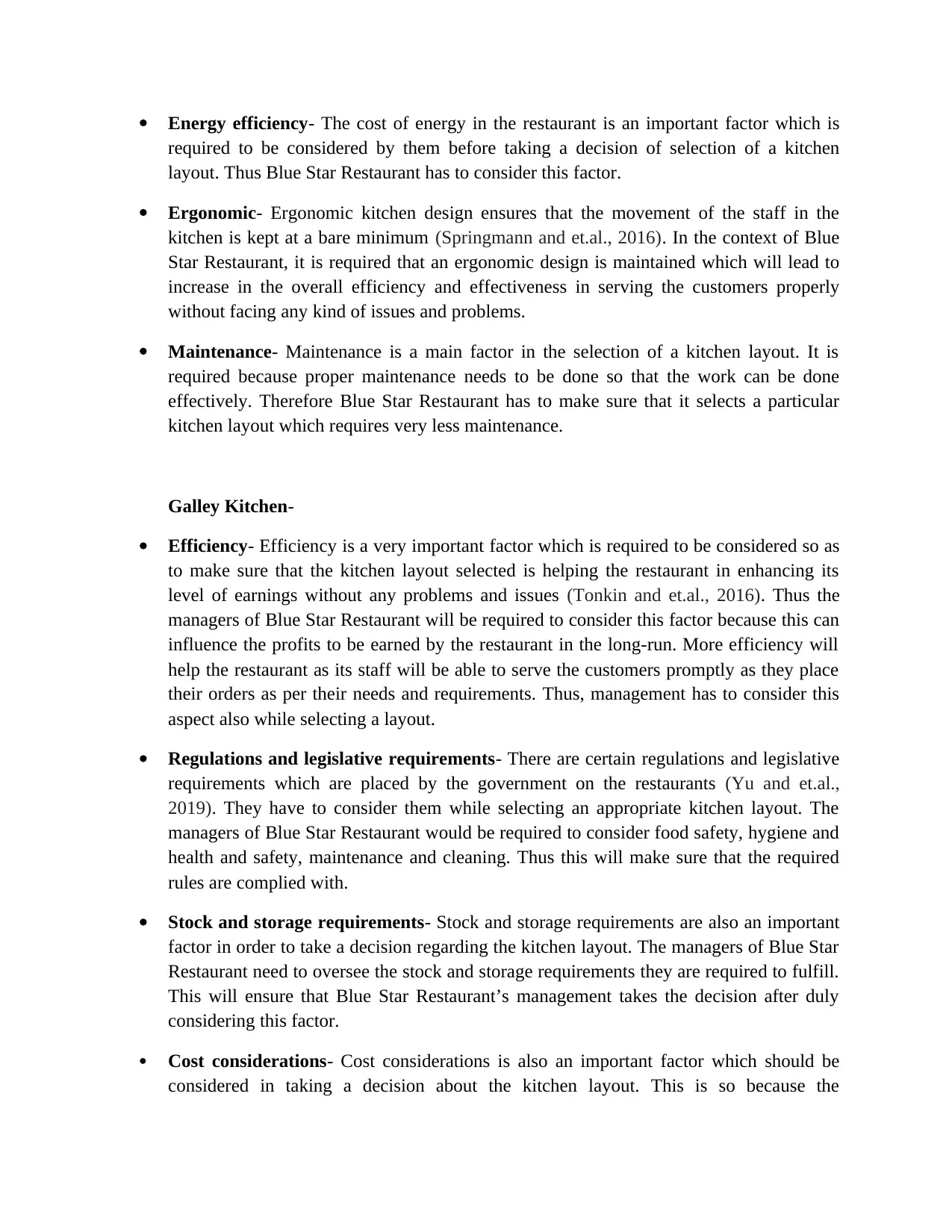
Energy efficiency- The cost of energy in the restaurant is an important factor which is
required to be considered by them before taking a decision of selection of a kitchen
layout. Thus Blue Star Restaurant has to consider this factor.
Ergonomic- Ergonomic kitchen design ensures that the movement of the staff in the
kitchen is kept at a bare minimum (Springmann and et.al., 2016). In the context of Blue
Star Restaurant, it is required that an ergonomic design is maintained which will lead to
increase in the overall efficiency and effectiveness in serving the customers properly
without facing any kind of issues and problems.
Maintenance- Maintenance is a main factor in the selection of a kitchen layout. It is
required because proper maintenance needs to be done so that the work can be done
effectively. Therefore Blue Star Restaurant has to make sure that it selects a particular
kitchen layout which requires very less maintenance.
Galley Kitchen-
Efficiency- Efficiency is a very important factor which is required to be considered so as
to make sure that the kitchen layout selected is helping the restaurant in enhancing its
level of earnings without any problems and issues (Tonkin and et.al., 2016). Thus the
managers of Blue Star Restaurant will be required to consider this factor because this can
influence the profits to be earned by the restaurant in the long-run. More efficiency will
help the restaurant as its staff will be able to serve the customers promptly as they place
their orders as per their needs and requirements. Thus, management has to consider this
aspect also while selecting a layout.
Regulations and legislative requirements- There are certain regulations and legislative
requirements which are placed by the government on the restaurants (Yu and et.al.,
2019). They have to consider them while selecting an appropriate kitchen layout. The
managers of Blue Star Restaurant would be required to consider food safety, hygiene and
health and safety, maintenance and cleaning. Thus this will make sure that the required
rules are complied with.
Stock and storage requirements- Stock and storage requirements are also an important
factor in order to take a decision regarding the kitchen layout. The managers of Blue Star
Restaurant need to oversee the stock and storage requirements they are required to fulfill.
This will ensure that Blue Star Restaurant’s management takes the decision after duly
considering this factor.
Cost considerations- Cost considerations is also an important factor which should be
considered in taking a decision about the kitchen layout. This is so because the
required to be considered by them before taking a decision of selection of a kitchen
layout. Thus Blue Star Restaurant has to consider this factor.
Ergonomic- Ergonomic kitchen design ensures that the movement of the staff in the
kitchen is kept at a bare minimum (Springmann and et.al., 2016). In the context of Blue
Star Restaurant, it is required that an ergonomic design is maintained which will lead to
increase in the overall efficiency and effectiveness in serving the customers properly
without facing any kind of issues and problems.
Maintenance- Maintenance is a main factor in the selection of a kitchen layout. It is
required because proper maintenance needs to be done so that the work can be done
effectively. Therefore Blue Star Restaurant has to make sure that it selects a particular
kitchen layout which requires very less maintenance.
Galley Kitchen-
Efficiency- Efficiency is a very important factor which is required to be considered so as
to make sure that the kitchen layout selected is helping the restaurant in enhancing its
level of earnings without any problems and issues (Tonkin and et.al., 2016). Thus the
managers of Blue Star Restaurant will be required to consider this factor because this can
influence the profits to be earned by the restaurant in the long-run. More efficiency will
help the restaurant as its staff will be able to serve the customers promptly as they place
their orders as per their needs and requirements. Thus, management has to consider this
aspect also while selecting a layout.
Regulations and legislative requirements- There are certain regulations and legislative
requirements which are placed by the government on the restaurants (Yu and et.al.,
2019). They have to consider them while selecting an appropriate kitchen layout. The
managers of Blue Star Restaurant would be required to consider food safety, hygiene and
health and safety, maintenance and cleaning. Thus this will make sure that the required
rules are complied with.
Stock and storage requirements- Stock and storage requirements are also an important
factor in order to take a decision regarding the kitchen layout. The managers of Blue Star
Restaurant need to oversee the stock and storage requirements they are required to fulfill.
This will ensure that Blue Star Restaurant’s management takes the decision after duly
considering this factor.
Cost considerations- Cost considerations is also an important factor which should be
considered in taking a decision about the kitchen layout. This is so because the
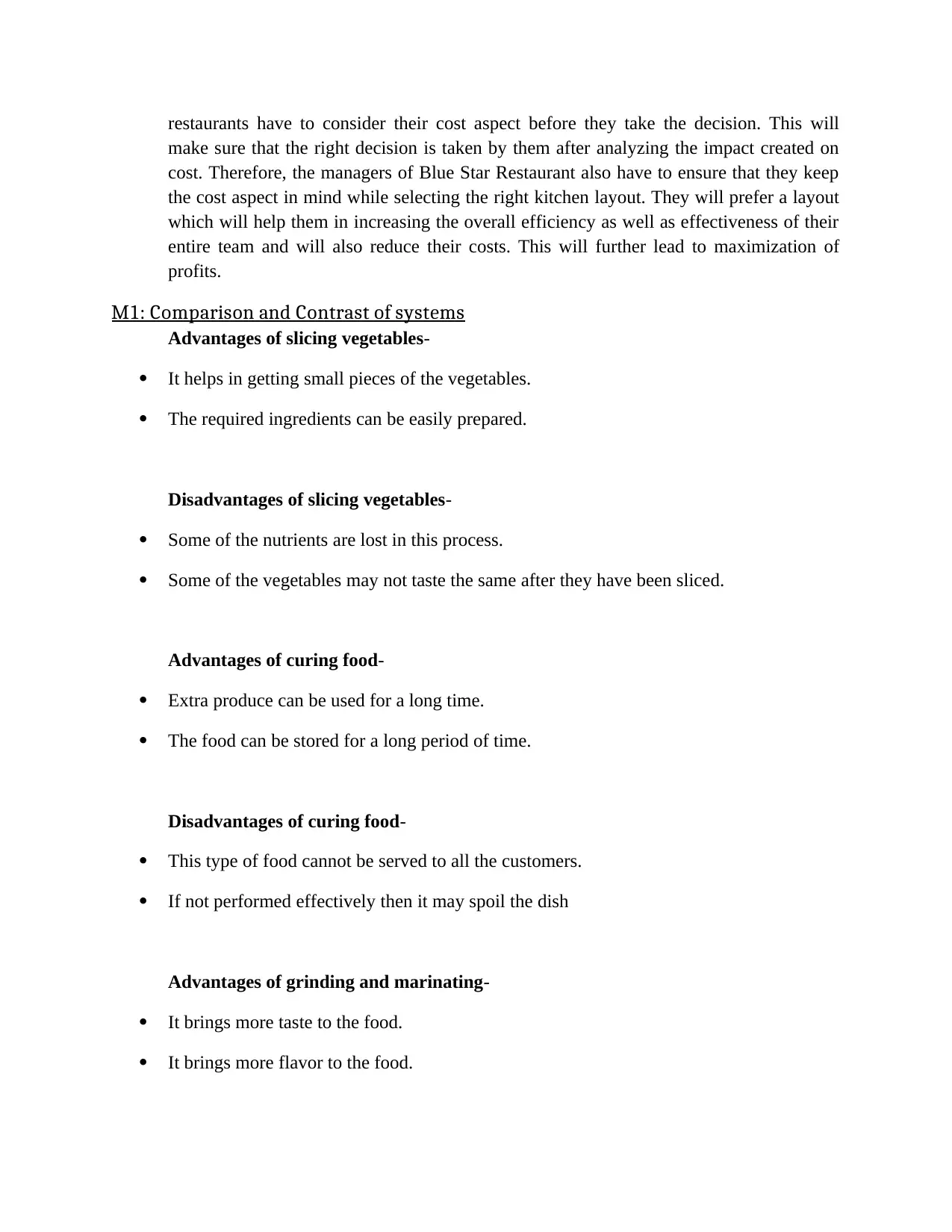
restaurants have to consider their cost aspect before they take the decision. This will
make sure that the right decision is taken by them after analyzing the impact created on
cost. Therefore, the managers of Blue Star Restaurant also have to ensure that they keep
the cost aspect in mind while selecting the right kitchen layout. They will prefer a layout
which will help them in increasing the overall efficiency as well as effectiveness of their
entire team and will also reduce their costs. This will further lead to maximization of
profits.
M1: Comparison and Contrast of systems
Advantages of slicing vegetables-
It helps in getting small pieces of the vegetables.
The required ingredients can be easily prepared.
Disadvantages of slicing vegetables-
Some of the nutrients are lost in this process.
Some of the vegetables may not taste the same after they have been sliced.
Advantages of curing food-
Extra produce can be used for a long time.
The food can be stored for a long period of time.
Disadvantages of curing food-
This type of food cannot be served to all the customers.
If not performed effectively then it may spoil the dish
Advantages of grinding and marinating-
It brings more taste to the food.
It brings more flavor to the food.
make sure that the right decision is taken by them after analyzing the impact created on
cost. Therefore, the managers of Blue Star Restaurant also have to ensure that they keep
the cost aspect in mind while selecting the right kitchen layout. They will prefer a layout
which will help them in increasing the overall efficiency as well as effectiveness of their
entire team and will also reduce their costs. This will further lead to maximization of
profits.
M1: Comparison and Contrast of systems
Advantages of slicing vegetables-
It helps in getting small pieces of the vegetables.
The required ingredients can be easily prepared.
Disadvantages of slicing vegetables-
Some of the nutrients are lost in this process.
Some of the vegetables may not taste the same after they have been sliced.
Advantages of curing food-
Extra produce can be used for a long time.
The food can be stored for a long period of time.
Disadvantages of curing food-
This type of food cannot be served to all the customers.
If not performed effectively then it may spoil the dish
Advantages of grinding and marinating-
It brings more taste to the food.
It brings more flavor to the food.
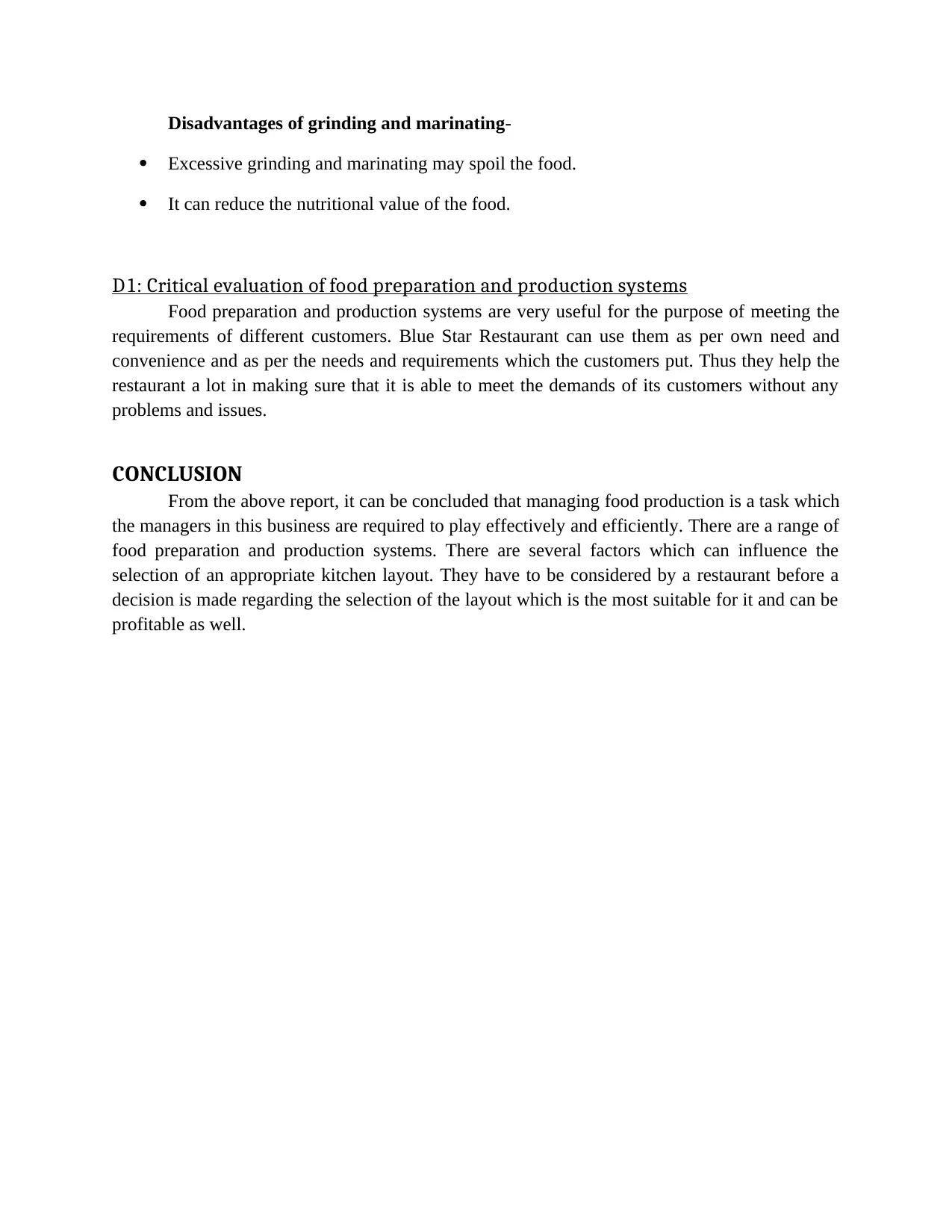
Disadvantages of grinding and marinating-
Excessive grinding and marinating may spoil the food.
It can reduce the nutritional value of the food.
D1: Critical evaluation of food preparation and production systems
Food preparation and production systems are very useful for the purpose of meeting the
requirements of different customers. Blue Star Restaurant can use them as per own need and
convenience and as per the needs and requirements which the customers put. Thus they help the
restaurant a lot in making sure that it is able to meet the demands of its customers without any
problems and issues.
CONCLUSION
From the above report, it can be concluded that managing food production is a task which
the managers in this business are required to play effectively and efficiently. There are a range of
food preparation and production systems. There are several factors which can influence the
selection of an appropriate kitchen layout. They have to be considered by a restaurant before a
decision is made regarding the selection of the layout which is the most suitable for it and can be
profitable as well.
Excessive grinding and marinating may spoil the food.
It can reduce the nutritional value of the food.
D1: Critical evaluation of food preparation and production systems
Food preparation and production systems are very useful for the purpose of meeting the
requirements of different customers. Blue Star Restaurant can use them as per own need and
convenience and as per the needs and requirements which the customers put. Thus they help the
restaurant a lot in making sure that it is able to meet the demands of its customers without any
problems and issues.
CONCLUSION
From the above report, it can be concluded that managing food production is a task which
the managers in this business are required to play effectively and efficiently. There are a range of
food preparation and production systems. There are several factors which can influence the
selection of an appropriate kitchen layout. They have to be considered by a restaurant before a
decision is made regarding the selection of the layout which is the most suitable for it and can be
profitable as well.
Secure Best Marks with AI Grader
Need help grading? Try our AI Grader for instant feedback on your assignments.
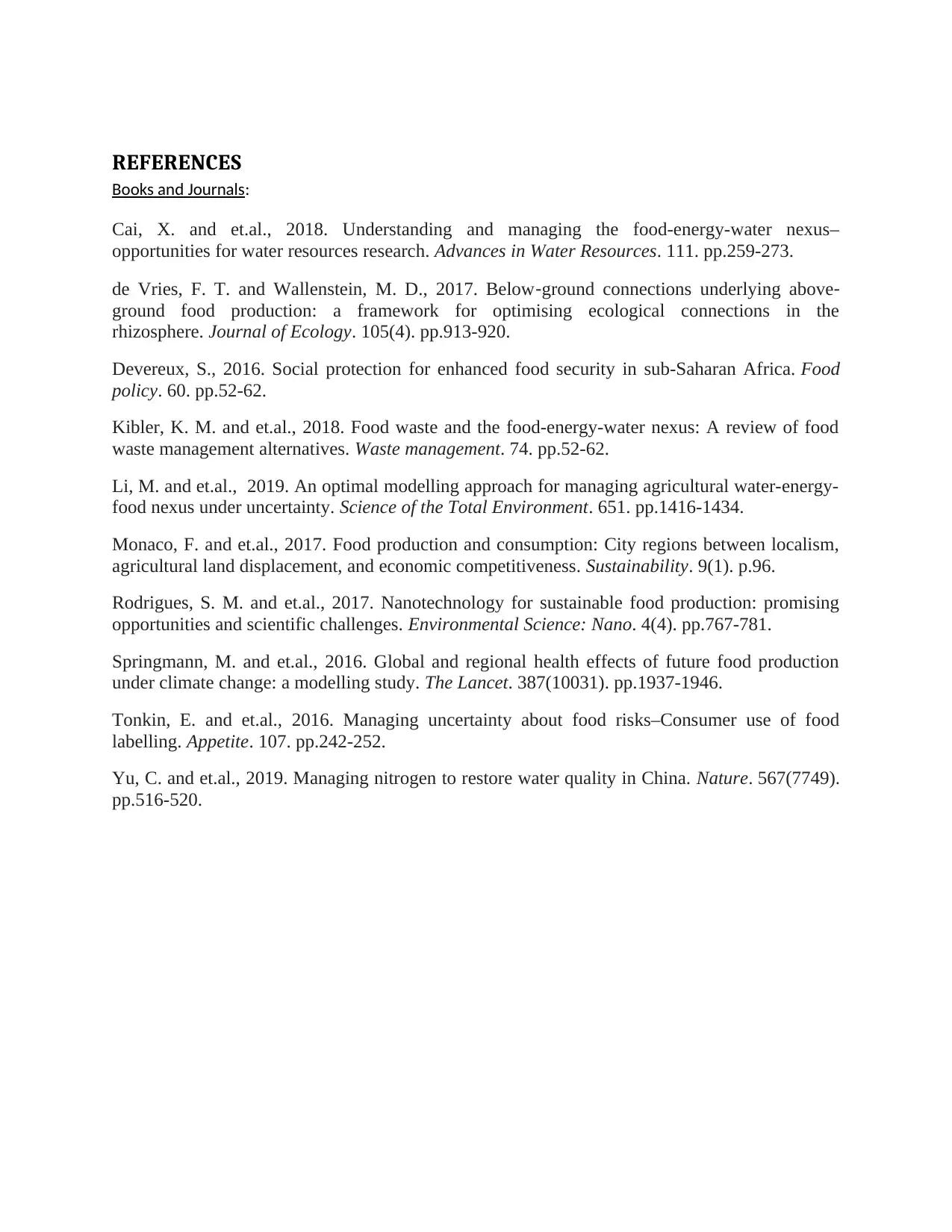
REFERENCES
Books and Journals:
Cai, X. and et.al., 2018. Understanding and managing the food-energy-water nexus–
opportunities for water resources research. Advances in Water Resources. 111. pp.259-273.
de Vries, F. T. and Wallenstein, M. D., 2017. Below‐ground connections underlying above‐
ground food production: a framework for optimising ecological connections in the
rhizosphere. Journal of Ecology. 105(4). pp.913-920.
Devereux, S., 2016. Social protection for enhanced food security in sub-Saharan Africa. Food
policy. 60. pp.52-62.
Kibler, K. M. and et.al., 2018. Food waste and the food-energy-water nexus: A review of food
waste management alternatives. Waste management. 74. pp.52-62.
Li, M. and et.al., 2019. An optimal modelling approach for managing agricultural water-energy-
food nexus under uncertainty. Science of the Total Environment. 651. pp.1416-1434.
Monaco, F. and et.al., 2017. Food production and consumption: City regions between localism,
agricultural land displacement, and economic competitiveness. Sustainability. 9(1). p.96.
Rodrigues, S. M. and et.al., 2017. Nanotechnology for sustainable food production: promising
opportunities and scientific challenges. Environmental Science: Nano. 4(4). pp.767-781.
Springmann, M. and et.al., 2016. Global and regional health effects of future food production
under climate change: a modelling study. The Lancet. 387(10031). pp.1937-1946.
Tonkin, E. and et.al., 2016. Managing uncertainty about food risks–Consumer use of food
labelling. Appetite. 107. pp.242-252.
Yu, C. and et.al., 2019. Managing nitrogen to restore water quality in China. Nature. 567(7749).
pp.516-520.
Books and Journals:
Cai, X. and et.al., 2018. Understanding and managing the food-energy-water nexus–
opportunities for water resources research. Advances in Water Resources. 111. pp.259-273.
de Vries, F. T. and Wallenstein, M. D., 2017. Below‐ground connections underlying above‐
ground food production: a framework for optimising ecological connections in the
rhizosphere. Journal of Ecology. 105(4). pp.913-920.
Devereux, S., 2016. Social protection for enhanced food security in sub-Saharan Africa. Food
policy. 60. pp.52-62.
Kibler, K. M. and et.al., 2018. Food waste and the food-energy-water nexus: A review of food
waste management alternatives. Waste management. 74. pp.52-62.
Li, M. and et.al., 2019. An optimal modelling approach for managing agricultural water-energy-
food nexus under uncertainty. Science of the Total Environment. 651. pp.1416-1434.
Monaco, F. and et.al., 2017. Food production and consumption: City regions between localism,
agricultural land displacement, and economic competitiveness. Sustainability. 9(1). p.96.
Rodrigues, S. M. and et.al., 2017. Nanotechnology for sustainable food production: promising
opportunities and scientific challenges. Environmental Science: Nano. 4(4). pp.767-781.
Springmann, M. and et.al., 2016. Global and regional health effects of future food production
under climate change: a modelling study. The Lancet. 387(10031). pp.1937-1946.
Tonkin, E. and et.al., 2016. Managing uncertainty about food risks–Consumer use of food
labelling. Appetite. 107. pp.242-252.
Yu, C. and et.al., 2019. Managing nitrogen to restore water quality in China. Nature. 567(7749).
pp.516-520.
1 out of 11
Related Documents
Your All-in-One AI-Powered Toolkit for Academic Success.
+13062052269
info@desklib.com
Available 24*7 on WhatsApp / Email
![[object Object]](/_next/static/media/star-bottom.7253800d.svg)
Unlock your academic potential
© 2024 | Zucol Services PVT LTD | All rights reserved.





